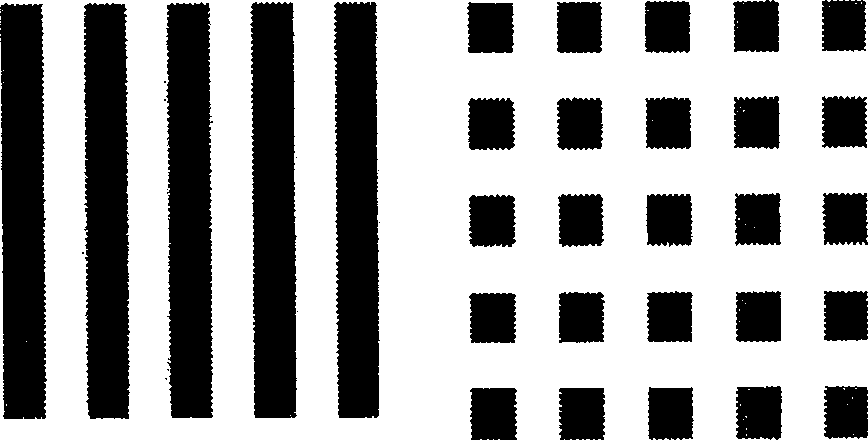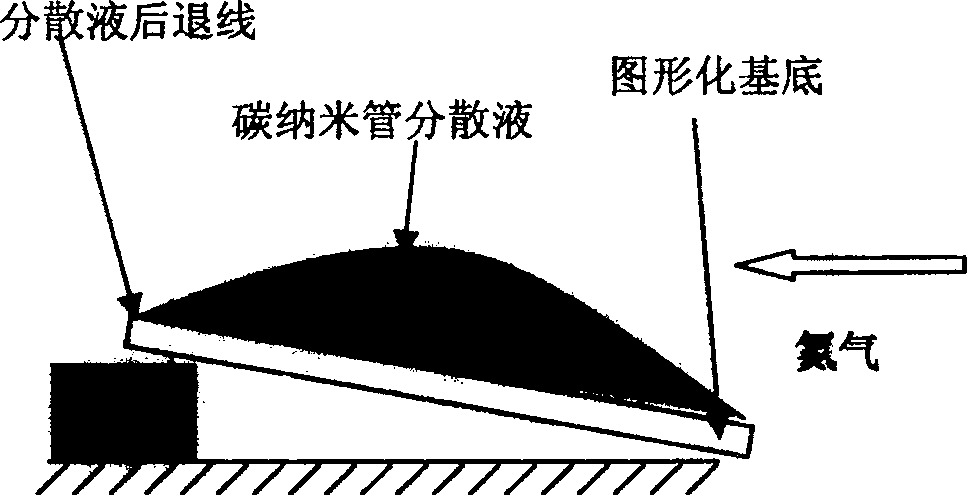Carbon tube nanometer tube figuring technique
A technology of carbon nanotubes and process methods, which can be applied in nanotechnology, nanotechnology, nanostructure manufacturing, etc., and can solve problems such as low efficiency and limitations
- Summary
- Abstract
- Description
- Claims
- Application Information
AI Technical Summary
Problems solved by technology
Method used
Image
Examples
Embodiment 1
[0030] Patterned deposition of carbon nanotubes on silicon substrates:
[0031] A single crystal silicon wafer N(100) is used as the substrate, and a layer of Megaposit SPR6112B photoresist is coated on it, and the photoresist is exposed according to the pre-designed stripes and dot patterns of different sizes. After exposure and development, the exposed silicon wafer is exposed. The OTS methyl surface self-assembly film was partially assembled, and then soaked in acetone to remove the remaining photoresist, and then the APTES amino surface self-assembly film was assembled on the silicon wafer after removal. In this way, a patterned self-assembled film surface (such as figure 1 shown).
[0032] The patterned functionally treated silicon substrates were immersed in SDS aqueous solution or DMF carbon nanotube dispersions (e.g. image 3 shown) for 16 hours, after taking out, rinse with deionized water or anhydrous methanol, respectively, and dry with nitrogen.
Embodiment 2
[0034] Patterned deposition of carbon nanotubes on electrode aluminum substrates:
[0035] A single crystal silicon wafer N(100) is used as the substrate, a layer of Al is sputtered on the cleaned silicon wafer, and then a layer of Megaposit SPR6112B photoresist is coated on the Al, and stripes and lattice patterns of different sizes are designed in advance. Expose the photoresist, then etch the exposed part of Al (phosphoric acid corrosion), assemble the OTS methyl surface self-assembly film on the silicon wafer part exposed by etching the Al, and then soak it in acetone for the photolithography of the Al surface Glue and degumming, and then assemble the APTES amino surface self-assembled film on top of the degummed Al to form patterns of different surface self-assembled films (such as figure 1 shown).
[0036] The patterned substrate was immersed in SDS aqueous solution or DMF carbon nanotube dispersion for 16 hours, then taken out and washed with deionized water or anhydro...
Embodiment 3
[0038] A patterned carbon nanotube film is obtained by a patterned casting process of carbon nanotubes on an aluminum electrode substrate.
[0039] A single crystal silicon wafer N(100) is used as the substrate, a layer of Al is sputtered on the cleaned silicon wafer, and then a layer of Megaposit SPR6112B photoresist is applied on the Al, and stripes and lattice patterns of different sizes designed by oneself are used. Expose the photoresist, then etch the Al in the exposed part, assemble the OTS methyl surface self-assembly film on the silicon wafer exposed by etching the Al, and then soak it in acetone to remove the photoresist on the Al surface, Hydroxylated again to form a hydrophobic OTS film and a pattern of hydrophilic aluminum (e.g. figure 1 shown).
PUM
| Property | Measurement | Unit |
|---|---|---|
| diameter | aaaaa | aaaaa |
| diameter | aaaaa | aaaaa |
Abstract
Description
Claims
Application Information
 Login to View More
Login to View More - R&D
- Intellectual Property
- Life Sciences
- Materials
- Tech Scout
- Unparalleled Data Quality
- Higher Quality Content
- 60% Fewer Hallucinations
Browse by: Latest US Patents, China's latest patents, Technical Efficacy Thesaurus, Application Domain, Technology Topic, Popular Technical Reports.
© 2025 PatSnap. All rights reserved.Legal|Privacy policy|Modern Slavery Act Transparency Statement|Sitemap|About US| Contact US: help@patsnap.com



